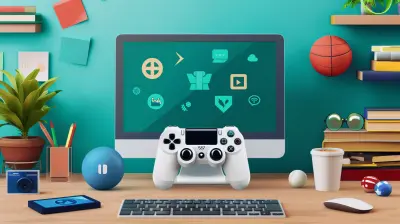Making Learning Visible: The Role of Self-Assessment in Tracking Progress
29 September 2025
Let’s get real for a minute—learning isn’t just about absorbing facts and passing tests. It’s about growth. It’s about becoming the best version of yourself, day by day, step by step. But how do you know if you're actually growing? That’s where self-assessment kicks in.
Self-assessment is like holding up a mirror to your learning. It helps you see what’s working, what’s not, and what needs tweaking. Instead of waiting for a teacher’s red pen to tell you how you’re doing, self-assessment puts the power in your hands.
In this bold guide, we're diving deep into the role of self-assessment in tracking progress. Whether you're a student trying to crush your goals, a teacher looking to empower learners, or a lifelong learner doing it for the love of it—this is for you.![]()
What is Self-Assessment, Really?
Let’s break it down. Self-assessment is when you evaluate your own work, performance, or learning process. It's more than just giving yourself a grade—it’s thinking critically about your understanding, effort, and progress.It's a mindset. It's saying, “Hey, I’m not just here to go through the motions—I’m here to grow.”
Not Just Guesswork
Don’t mistake self-assessment for simply patting yourself on the back or beating yourself up. It’s not about guessing how well you did; it’s about reflecting with purpose. You ask questions like:- What did I do well?
- Where did I get stuck?
- How can I do better next time?
You turn reflection into fuel for improvement.![]()
Why Should We Care About Making Learning Visible?
Because let’s face it—learning is often invisible. You sit through lessons, do assignments, take tests, and repeat. But progress? It's hidden in the margins. Self-assessment makes that learning visible. It shines a big ol’ spotlight on where you started, where you are now, and where you want to go.It Puts You in the Driver’s Seat
Waiting for external feedback is like driving blindfolded and relying on your passenger to yell directions. Self-assessment hands you the steering wheel. You navigate your own journey. That’s powerful.It Builds Confidence and Ownership
When you’re aware of your strengths and can spot your weaknesses, you stop depending entirely on someone else's opinion. You know where you stand and what you’ve got to do next. That’s real empowerment.The Research Doesn’t Lie: Self-Assessment Works
Let’s pause for a sec and talk evidence. Studies have shown that students who engage in regular self-assessment tend to:- Have higher motivation
- Perform better academically
- Develop stronger metacognitive skills (that’s just a fancy way of saying they think about their own thinking)
In plain terms? Self-assessment helps you learn HOW to learn.![]()
The Key Elements of Effective Self-Assessment
Okay, so how do you actually DO self-assessment the right way? It’s not just ticking boxes or journaling your feelings (although those help too). Here's what makes self-assessment truly effective:1. Clear Learning Goals
You can't assess progress if you don’t know what you’re aiming for. Start with clear, concrete objectives. Think: “I want to be able to solve quadratic equations,” not “I want to be better at math.”2. Honest Reflection
Self-assessment only works if you're real with yourself. Don’t sugarcoat it, but don’t be harsh either. Be honest. Be kind. Be constructive.3. Evidence-Based
Don’t just guess how you did—look at your actual work. What does it say? Use rubrics, checklists, portfolios, or even progress trackers. Let the data speak.4. Action Steps
Reflection without action is like spinning your wheels in the mud. End each self-assessment with a plan. What’s the next step? What will you change, try, or improve?Self-Assessment in Action: Real-Life Examples
Let’s talk real talk. What does self-assessment look like in daily learning?In the Classroom
Teachers might ask students to:- Give themselves a rating on a specific skill
- Reflect on what they struggled with during a project
- Write a short paragraph about what they’ve learned this week
Bonus: Teachers can also read student reflections to tailor their teaching. Win-win.
In Online Learning
With the rise of e-learning, self-assessment is even easier. Many platforms now include:- Progress dashboards
- Self-evaluation surveys
- Interactive quizzes with instant feedback
You can literally see your growth charted out before your eyes.
For Self-Taught Learners
If you're learning on your own—whether it’s coding, Spanish, or guitar—self-assessment keeps you accountable. You might:- Record your progress weekly
- Set personal benchmarks
- Reflect using a learning journal
The key is consistency.
How Teachers Can Foster a Self-Assessment Culture
Teachers, this one’s for you. If you want your students to own their learning, you’ve got to make space for self-assessment. Here’s how:Normalize Reflection
Build it into your routine. Start or end lessons with a 5-minute reflection. Make it as normal as raising your hand.Model It Yourself
Let students see YOU reflecting. Share your own growth process. “I tried a new way to explain that topic today—what did you think?”Provide Tools, Not Just Tasks
Give students the tools to reflect meaningfully:- Checklists
- Self-assessment rubrics
- Guided reflection questions
Don’t just say, “Reflect.” Show them how.
Roadblocks to Watch Out For
Of course, no method is perfect. Here are a few bumps in the road—and how to smooth them out.Over-Rating or Under-Rating Themselves
Some learners think they’re killing it when they’re not. Others beat themselves up no matter what. Calibration helps. Compare self-assessments with teacher feedback to bridge the gap.Lack of Structure
If self-assessment is too vague, it won’t stick. Use structure—questions, prompts, and timelines. It shouldn’t feel like a guessing game.Fear of Being Wrong
Some students are afraid to admit they don’t understand. Create a classroom culture where honesty is valued over perfection. Progress starts with truth.The Bigger Picture: Lifelong Learning
Here’s the kicker—self-assessment isn’t just for students. It’s a life skill.In your career, your relationships, your hobbies—reflecting on what’s working and what’s not is everything. Self-assessment turns you into a learning machine. You'll never stop growing, improving, evolving.
It’s like having an internal GPS that keeps rerouting you to your ideal destination—even when you take a few wrong turns.
Tools & Tips to Boost Self-Assessment
Want to level up your self-assessment game? Check out these tools and strategies:1. Learning Journals
Keep a daily or weekly journal focused on what you learned, what challenged you, and what you’ll do next.2. Digital Progress Trackers
Use spreadsheets, apps, or dashboards to track your progress over time.3. Video Reflections
Record short videos explaining what you learned. It’s like a learning diary… but with your face.4. Peer Feedback
Sometimes a friend’s perspective can help you spot blind spots. Swap self-assessments and compare notes.Final Thoughts: Make Your Learning Count
If you want to grow, you’ve got to know. Self-assessment is your secret weapon. It’s honest, raw, and empowering. It takes your progress out of the shadows and puts it in plain sight. So stop waiting for someone to tell you how you’re doing—look in the mirror, size things up for yourself, and keep pushing forward.Because the only person who truly tracks your progress… is you.
all images in this post were generated using AI tools
Category:
Self AssessmentAuthor:

Anita Harmon
Discussion
rate this article
1 comments
Thalia White
Self-assessment empowers learners by fostering reflection and ownership of their progress. Incorporating regular self-evaluations in the learning process helps students identify strengths and areas for improvement, ultimately enhancing motivation and facilitating deeper understanding of their educational journey.
October 13, 2025 at 3:53 AM

Anita Harmon
Thank you for your insightful comment! I completely agree—self-assessment is key in promoting reflection and ownership, ultimately enhancing both motivation and understanding in the learning process.


